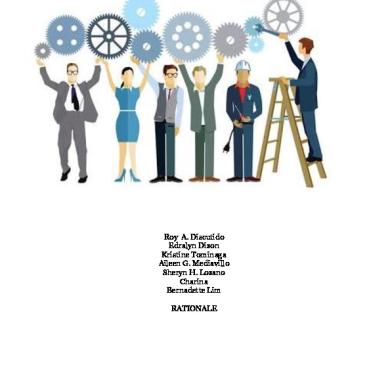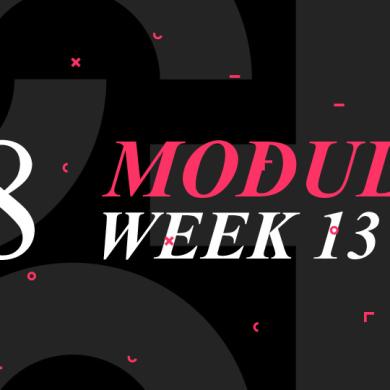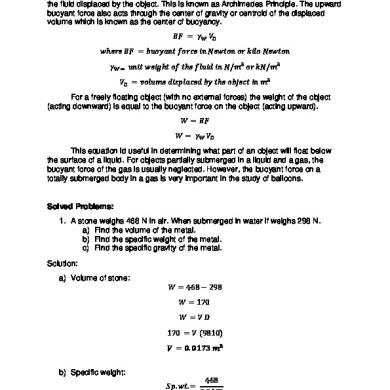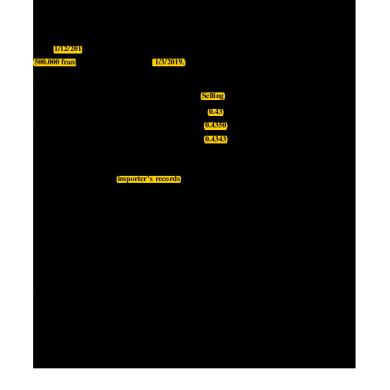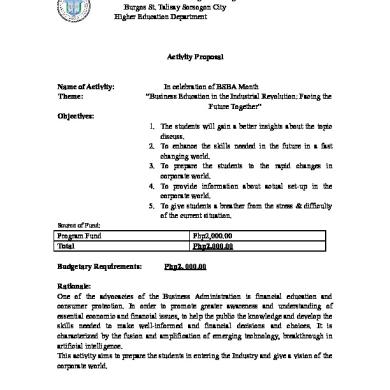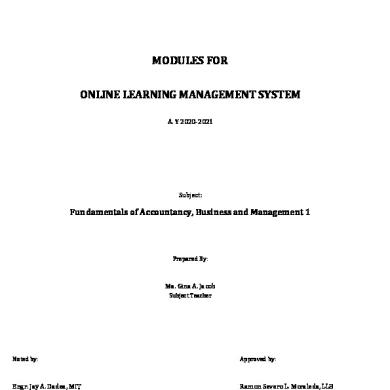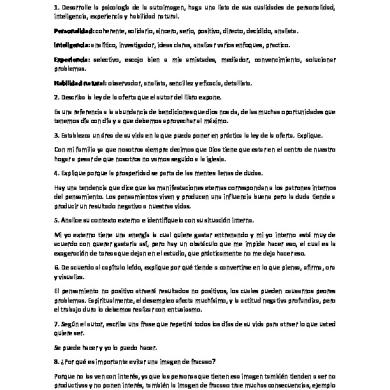* The preview only shows a few pages of manuals at random. You can get the complete content by filling out the form below.
Description
MODULE 5 & 6
Learning Outcome: At the end of the lesson, the students will be able to: 1. Defined as a clear and concise measurable statement of the behaviours 2.
Behavioural strategies * Problem solving * Self-monitoring * Goal setting (Plan: what, how, when) * Social support Self-rewards (reinforcement) *Cognitive restructuring (CBT) Behavioral definition Behaviour- a set of actions; the ways we conduct ourselves; the things that we do. Developing a successful Intervention: key Components Identify and know your target populations Identify the behavioral goals Identify the influencing factors Identifying the appropriate strategy for affecting each influencing factors. Personal Influences that Impact Behaviour Risk Appraisal: What are my chance of becoming infected because of what I do? Self Perception: What do I do about my ability to avoid risk? Emotions and Arousal: How my feelings affect my behaviour? Relationship/Social Influence: What people, places and things affect me? Environmental: How does society influence my behaviour? How do I Change my Behaviour? Identify a behavior you changed or tried to change. What was the impact of the behaviour on your health? How much did the change affect your life? Who/what were the obstacles to changing? What was the reward for changing? Who/what were your helper for change?
11
MODULE 5 & 6
Behaviour Change Increased interest of behaviour change in different fields with the hope that understanding it will improve the services offered ◦ Health ◦ Education ◦ Criminology ◦ Energy ◦ International development Behavioural change theories have gained recognition in health for their possible effectiveness in explaining health- related behaviours and providing insight into methods that would encourage individuals to develop and maintain healthy lifestyles
Behaviour Change Different terms used for behaviour change ◦ Strategic Behavioral Communication (SBC) ◦ Information, Education, Communication (IEC) ◦ Communication for Social Change (CSC) ◦ Behaviour change communication (BCC)
Behaviour Change Many theories exist for Behaviour change, the most prevalent are ◦ Learning theories ◦ Social Cognitive Theory ◦ Theories of Reasoned Action and Planned Behaviour ◦ Trans-theoretical Model ◦ Health Action Process Approach
12
MODULE 5 & 6 Why Do People NOT Change Behavior? People may not ◦ Understand the message ◦ See themselves as vulnerable ◦ Trust the bearers of the message People may ◦ Think the short-term benefits of current behaviors outweigh the long-term risks Some “healthy choices” are costly Recommended behavior may conflict with beliefs After all, people believe that malaria is a common disease and is not so serious Can you name more reasons? Theory of Behaviour Change Pavlov’s Classical Conditioning Skinner’s Operant Behavioursim
13
MODULE 5 & 6
Behavior change is a continuous process It involves strong community participation Refutes myths and corrects misunderstanding Social norms and public policies influence behavior change. A strategic shift must be also be attempted simultaneously. BCC often complements and supports other prevention strategies and What influence Behaviour? a. Human behaviour is influenced by a huge range of factors. b. Why we do what we do into some key factors and principles that are important to consider when designing communications aimed at influencing behaviour change. ‘Individual behaviours are deeply embedded in social and institutional contexts. c. We are guided as much by what others around us say and do, and by the “rules of the game” as we are by personal choice.’
Some factors that influence behavioral change Physical stimuli Rational stimuli Skills Knowledge Social cultural factors Demographic-age, sex, etc Previous experiences Attitudes Steps to Behavior Change Knowledge 1. Recalls family planning messages. 2. Understands what family planning means. 3. Can name family planning method(s) and/or source of supply. Approval 4. Responds favorably to family planning messages. 5. Discusses family planning with personal networks (family, friends) 6. Thinks family, friends, and community approve of family planning. 7. Approves of family planning. Intention 8. Recognizes that family planning can meet a personal need. 9. Intends to consult a provider. 10. Intends to practice family planning at some time. Practice 11. Goes to a provider of information/supplies/services. 12. Chooses a method and begins family planning use. 13. Continues family planning use. Advocacy 14. Experiences and acknowledges personal benefits of family planning. 15. Advocates practice to others. 16. Supports programs in the community.
14
MODULE 5 & 6
Steps to Behavior Change These are the ideal steps one follows towards behavior change. They may apply to health workers or community members Knowledge: • One first learns about a new behavior (injection safety practices) • Recalls messages on Injection Safety and understands meaning of the messages • Can name Injection safety strategies and practices Approval: • One then approves of the new behavior (Injection safety Strategies) • Responds favorably to injection safety messages • Discusses injection safety with personal network (professional, colleagues, family and friends) • Thinks professional colleagues, family, friends and Intention: • One then believes this behavior is beneficial to them and intends to adopt it. • Recognizes that Injection safety strategies can meet a personal need • Intends to adopt injection safety practices Practice: • One then attempts new behavior and continues to practice. (Practices proposed under each strategy in injection safety) Advocacy • One can then promote the new behavior through their social or professional networks as a satisfied practitioner . • Experiences and acknowledges personal benefits of
Specific Determinants of Behavior
15
MODULE 5 & 6 What are some of the specific determinants of behavior we can examine? This is another useful checklist that helps to reinforce and reiterate some of the concepts previously covered. If you consider the range of items that determine behavior, it is useful to ask the following questions when designing a social marketing campaign: •Do I know the knowledge and skill levels of my target audience? •Do I understand how they view risk? •What do they see as the perceived risk to themselves and to others for the suggested behavior? •What are their attitudes and beliefs? •What consequences do they perceive? •Do they feel a sense of self-efficacy whatever their social norms, intentions or demographics? •Finally, what are any other relevant or pertinent characteristics we need to know? Variables Underlying Behavioral Performance “Generally speaking it appears that in order for a person to perform a given behavior one or more of the following must be true: 1. The person must have formed a strong positive intention (or made a commitment) to perform the behavior; 2. There are no environmental constraints that make it impossible to perform the behavior; 3. The person has the skills necessary to perform that behavior; 4. The person believes that the advantages (benefits, anticipated positive outcomes) of performing the behavior outweigh the disadvantages (costs, anticipated negative outcomes); Variables Underlying Behavioral Performance 5. The person perceives more social (normative) pressure to perform the behavior than to not perform the behavior; 6. The person perceives that performance of the behavior is more consistent than inconsistent with his or her self image, or that it’s performance does not violate personal standards that activate negative self-actions; 7. The persons emotional reaction to performing the behavior is more positive than negative; 8. The person perceives that he or she has the capabilities to perform the behavior under a number of different circumstances…” Which Determines Behavior: Self-efficacy? Other relevant characteristics? 1. Knowledge and Skills Very briefly, the first thing to look at is the knowledge and skills of our audience What do people know about the program? Do they know how to do the target behavior? Can they access the program or service? What do we need to do to ensure they receive needed information?
16
MODULE 5 & 6 2. Perceived Risk Does the target audience believe they are personally susceptible or vulnerableto the kinds of problems or health issues that may incur if they do or do not perform certain behaviors? How severe do they perceive the condition to be? While we do not want to frighten people or use their appeals in a non-judicious way, sometimes we need to point out the kinds of risk people face to motivate them to think about behavioral changes. 3.
Attitudes What are the attitudes of the target audience? How do they feel about the program, service, or target behavior and the behavior we are offering? Are there rumors in the community which would affect their attitude?
4.
Perceived Consequences What does the target audience believe they will gain if they adopt the target behavior? What does the target audience believe they will lose if they adopt the behavior? How can we address this situation?
5. Self-efficacy Defined: Self-efficacy is An individual’s belief that he/she can do a desired behaviour Do consumers believe they can adopt the target behavior the types of behaviors we are asking them to do? Do they feel they would be successfully? We need to make sure everyone has the sense they can succeed and find out what problems would prevent them from succeeding. 6. Social Norms Defined: Social norms are the standards of behavior for attitude accepted as usual practice by groups of people. What do consumers perceive the norms to be? People do not like to act counter to social norms, because they feel a sense of approval and reinforcement through the people around them. Going against social norms may be too steep of price to pay, so we need to know what those norms are before advocating certain kinds of change. 7. Intentions Intentions ask What does the audience already plan to do about the new behavior? How ready are they to change? We know if people have strong intentions, that means they are fairly ready to change behavior. This predicts behavior far better than we once thought. Therefore, intentions are our important motivator for helping people move to activation. 8. Demographics - Race / Ethnicity - Where they live - Age / Gender - Education - Religion - Marital status - Income - Sexual orientation - Occupation 9. Other Social-Psychological Determinants - Self concept / Self esteem - hopes, fears, aspirations
17
MODULE 5 & 6 - Occupational stress - Religiosity - Recreation and leisure - Social support networks - Media habits - what they watch, listen, read - how often? where? when? Some Behavior Change Tools • Education Effective when goals of society align with those of target audience Benefits are attractive, immediate, obvious, low costs, skills/resources to change are available •Law/policy development Effective when citizens are unlikely to change on their own, and society is unwilling to pay the costs associated with risky/unhealthy behavior •Marketing Effective when goals of society and those of the citizens are not entirely consistent, but citizens can be influenced to change Changing behaviors: A Practical Framework ◦ The person has formed a strong positive intention (or made a commitment) to perform the behaviour. ◦ There are no environmental constraints that make it impossible for the behaviour to occur. ◦ The person has the skills necessary to perform the behaviour. ◦ The person believes the advantages (benefits, anticipated positive outcomes) of performing the behaviour outweigh the disadvantages (costs, anticipated negative ◦ The person perceives more social pressure to perform the behaviour than to not perform the behaviour. ◦ The person perceives that the behaviour is consistent with their self-image and does not violate their personal standards. ◦ The person’s emotional reaction to performing behaviour is more positive than negative. ◦ The person believes (has confidence) that they can execute the behaviour under a number of different circumstances (i.e., the person has the perceived self-efficacy to
18
MODULE 5 & 6
ACTIVITY Direction: In each box, write ten (10) behaviors that are either acceptable or unacceptable. Below the box, put two examples of your acceptable and unacceptable behaviour and choose one of your unacceptable behaviour and what did you do to make it acceptable.
19



